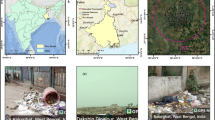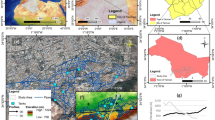Abstract
Locating additional drillholes based on information gathered from the initial drilling is a very difficult decision-making step in the process of detailed explorations. The most appropriate locations for additional drillholes are those wherein the information gathered from drilling has more value compared to that from other locations. From among the common methods proposed in information systems for measuring the information value, use of the “realistic value” is a very practical one. The realistic value of information is derived from measuring the differences in the decision makers’ performances when provided with different information sets. On this basis, a mathematical model has been proposed in this paper for optimal location of additional drillholes where the information gathered from drillholes has the highest possible value. Due to the combinatorial nature of this model, use has been made of a simulated annealing-based algorithm for its solution. The proposed model has been applied in Sungun copper deposit for locating additional drillholes; results have revealed that the model is valid.






Similar content being viewed by others
References
Botin, J. A. (2009). Sustainable management of mining operations. Littleton, CO: Society for Mining, Metallurgy and Exploration.
CMMI. (1996). Mineral resource/reserve classification: Categories, definitions and guidelines. A. H. C. Report, CIM Bulletin, Vol. 89, pp. 39–44.
Debba, P., Carranza, E. J. M., Stein, A., & Van der Meer, F. D. (2009). Deriving optimal exploration target zones on mineral prospectivity maps. Mathematical Geosciences, 41, 421–446.
Froyland, G., Menabde, M., et al. (2007). The value of additional drilling to open pit mining projects. In R. Dimitrakopoulos (Ed.), Orebody modelling and strategic mine planning (pp. 225–232). Melbourne: The Australasian Institute of Mining and Metallurgy.
Geman, S., & Geman, D. (1984). Stochastic relaxation, Gibbs distribution and the Bayesian restoration of images. IEEE Transactions on Pattern Analysis and Machine Intelligence, 6, 721–741.
Gershon, M., Allen, L. E., et al. (1988). Application of a new approach for drillholes location optimization. International Journal of Surface Mining, Reclamation, and Environment, 2(1), 27–31.
JORC. (1999). Australasian code for reporting of mineral resources and ore reserves. Resource document. Report of the joint committee of the AusIMM and AIG and Mineral council of Australia. Retrieved December 2012 from www.jorc.org/docs/jorc_code2012.pdf.
Kirkpatrick, S., Gelatt, C. D., et al. (1983). Optimization by simulated annealing. Science, 220(4598), 671–680.
Mwasinga, P. P. (2001). Approaching resource classification: General practices and the integration of geostatistics. In H. M. Xie & Y. Wang (Eds.), Computer applications in the minerals industry (pp. 97–104). London: Taylor & Francis Group.
Nahar, S., Sahni, S., & Shragowitz, E., (1985). Experiments with simulated annealing. In H. Ofek, L. A. O’Neill (Eds.), 22th ACM/IEEE Conference on Design Automation (pp. 748–752). Nevada, United States.
Saikia, K., & Sakara, B. C. (2006). Exploration drilling optimization using geostatistics: A case in Jharia Coalfield, India. Applied Earth Science, 115(1), 13–22.
SAMAREC. (2000). South African code for reporting mineral resource and ore reserves. Resource document. South African Institute of Mining and Metallurgy. Retrieved June 2009 from www.samcode.co.za.
Scheck, D., & Chou, D.-R. (1983). Optimum locations for exploratory drill holes. International Journal of Mining Engineering, 1(4), 343–355.
Sinclair, A. J., & Blackwell, G. H. (2000). Resource/reserve classification and the qualified person. Bulletin of the Canadian Institute of Mining and Metallurgy, 93(1038), 29–35.
Soltani, S., & Hezarkhani, A. (2009). Additional exploratory boreholes optimization based on three-dimensional model of ore deposit. Archives of Mining Science, 54(3), 495–506.
Soltani, S., & Hezarkhani, A. (2011). Determination of realistic and statistical value of the information gathered from exploratory drilling. Natural Resources Research, 20(4), 207–216.
Soltani, S., & Hezarkhani, A. (2013). Proposed algorithm for optimization of directional additional exploratory drill holes and computer coding. Arabian Journal of Geosciences, 6(2), 455–462.
Soltani, S., Hezarkhani, A., et al. (2011a). Optimally locating additional drill holes in three dimensions using grade and simulated annealing. Journal of the Geological Society of India, 80(5), 700–706.
Soltani, S., Hezarkhani, A., et al. (2011b). Use of genetic algorithm in optimally locating additional drill holes. Journal of Mining Science, 47(1), 62–72.
Szidarovszky, F. (1983). Multi-objective observation network design for regionalized variables. International Journal of Mining Engineering, 1(4), 331–342.
UN-ECE. (1996). United Nations international framework classification for reserves/resources solid fuels and mineral commodities. Genève: United Nations Publications.
van Groenigen, J. W., & Stein, A. (1998). Constrained optimization of spatial sampling using continuous simulated annealing. Journal of Environmental Quality, 27(5), 1078–1086.
Webster, R., & Oliver, M. A. (2007). Geostatistics for environmental scientists. Chichester: Wiley.
Wellmer, F. W. (1983). Classification of ore reserves by geostatistical methods. Erzmetall, 36(7/8), 315–321.
Acknowledgments
We are indebted to Dr. John Carranza at James Cook University for his critical and careful review of a preliminary version of this manuscript. We also appreciate constructive comments from one anonymous reviewer.
Author information
Authors and Affiliations
Corresponding author
Rights and permissions
About this article
Cite this article
Soltani-Mohammadi, S., Hezarkhani, A. A Simulated Annealing-Based Algorithm to Locate Additional Drillholes for Maximizing the Realistic Value of Information. Nat Resour Res 22, 229–237 (2013). https://doi.org/10.1007/s11053-013-9212-x
Received:
Accepted:
Published:
Issue Date:
DOI: https://doi.org/10.1007/s11053-013-9212-x




